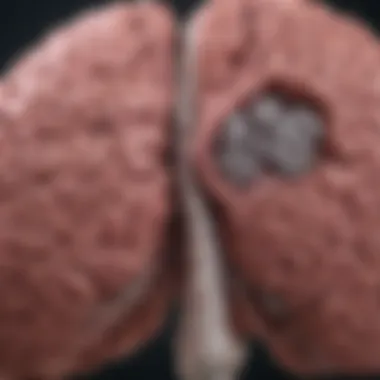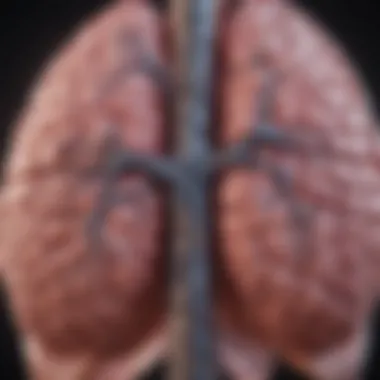Understanding Stage 4 Lung Cancer with Brain Metastases


Intro
The journey through lung cancer, especially at stage 4, is fraught with hurdles that few can truly comprehend unless they've been on this path themselves. When lung cancer spreads, or metastasizes, to the brain, the stakes undeniably rise. Patients and their families often face a barrage of uncertainties that complicate treatment decisions and affect quality of life.
This article aims to shine a light on the problems associated with this advanced stage of lung cancer, discussing the multifaceted nature of its prognosis when brain metastases are involved. To do this, we will dissect the biological undercurrents, the treatment options available, as well as survival rates tied to personalized care strategies.
Research Background
Overview of the Scientific Problem Addressed
When lung cancer cells find their way to the brain, they not only affect the brain's functions but also alter the body's ability to respond to standard treatments. The situation is akin to a chess game where each move has immediate repercussions. It’s about understanding how to maintain control over a rapidly changing battlefield.
Historical Context and Previous Studies
Historically, studies have often focused on lung cancer as a singular entity, with treatment paradigms aimed at the lungs alone. However, groundbreaking research has shown that treatment must take into account the brain's unique environment. Past studies, such as those published in the Journal of Clinical Oncology, have demonstrated the necessity of tailoring interventions to target both lung and brain lesions.
Learning from these earlier works provides a roadmap for understanding survival outcomes as well as the challenges of late-stage management. Furthermore, there have been advancements in imaging techniques that provide clearer insights into how metastases impact both quality and length of life.
Findings and Discussion
Key Results of the Research
Research indicates that the mere presence of brain metastases can significantly decrease survival rates. The median survival for patients dealing with both stage 4 lung cancer and brain involvement has shown variability, often ranging from a few months to over a year depending on individual health factors and treatment choices.
Factors influencing prognosis include:
- Type of lung cancer (non-small vs. small cell)
- Patient's overall health and comorbidities
- Response to initial treatments like chemotherapy or targeted therapy
- Genetic mutations, such as EGFR or ALK, which may dictate treatment efficacy
"Understanding these factors can lead to more informed decisions and ultimately better outcomes for the patient."
Interpretation of the Findings
An interpretation of available data suggests that patients who actively participate in personalized treatment plans, which may include a combination of chemotherapy, radiation, and targeted therapies, have a better shot at managing both symptoms and life expectancy than those who do not.
Additionally, integrative approaches, such as including palliative care early in the treatment process, have shown promising results in improving quality of life, even amid a bleak prognosis. This nuanced stance underscores the importance of viewing each patient as an individual rather than just another case of cancer, ensuring that care is both comprehensive and compassionate.
Understanding Lung Cancer
Understanding lung cancer is essential in navigating the complexities associated with its late-stage manifestations and treatment options. Lung cancer remains one of the most prevalent malignancies worldwide, leading to a significant burden on patients and healthcare systems alike. This article takes a thorough look at stage 4 lung cancer, especially when it has spread to the brain, which complicates both treatment strategies and prognoses. By grasping the nuances of lung cancer—the types, staging, and eventual implications—we can better appreciate how these factors interplay with prognosis and quality of life.
Definition and Types
Lung cancer primarily refers to the uncontrolled growth of abnormal cells in the lungs. These malignancies can be broadly categorized into two main types:
- Non-Small Cell Lung Cancer (NSCLC): This is the most common type, making up about 85% of cases. It further divides into subtypes, including adenocarcinoma, squamous cell carcinoma, and large-cell carcinoma.
- Small Cell Lung Cancer (SCLC): This type accounts for about 15% of lung cancer cases and is known for its aggressive nature and rapid growth.
Understanding these distinctions is crucial, as they directly impact treatment choices and prognostic outcomes. For instance, NSCLC generally has more favorable prognosis compared to SCLC, especially in earlier stages.
Staging of Lung Cancer
Staging refers to the process of determining the extent of cancer in the body. Lung cancer staging usually follows the TNM classification:
- T (Tumor Size): The size of the primary tumor and how far it has invaded nearby tissues.
- N (Nodes): The involvement of regional lymph nodes.
- M (Metastasis): The presence of metastases in other parts of the body, such as the brain or liver.
In the context of this article, stage 4 lung cancer indicates that the disease has metastasized to distant sites, marking it as an advanced stage where treatment complexities escalate. Understanding the stages allows clinicians to tailor personalized treatment plans, taking into consideration not only the cancer's location but also the patient's overall health and preferences.
Prognosis can vary widely based on numerous factors, including cancer type, patient health, and response to treatment.
Comprehensively understanding lung cancer, its types, and how it's staged is essential as we explore the important aspects of prognosis, especially in the context of stage 4 lung cancer with brain metastases. By doing so, patients, families, and healthcare professionals can work together to make informed decisions regarding treatment pathways and support systems.
Characteristics of Stage Lung Cancer
Understanding the characteristics of stage 4 lung cancer is vital to grasp both the implications of the disease and how it impacts patients. This stage, marked by the spread of cancer beyond the lungs to other parts of the body, signifies a critical turning point in the treatment landscape. Patients diagnosed with stage 4 lung cancer often face a particularly challenging journey, not only due to the advanced nature of the disease but also because of the myriad symptoms that can arise.
Definition and Diagnostic Criteria
Stage 4 lung cancer is defined as the most advanced stage of the disease, where cancer has metastasized to distant organs, including the brain, bones, liver, or adrenal glands. Such widespread spread significantly hampers treatment options and influences prognosis.
To confirm a diagnosis of stage 4 lung cancer, various diagnostic criteria are employed. Key components include:
- Imaging Studies: Techniques like CT scans, MRIs, or PET scans help visualize the extent of cancer spread.
- Biopsy: Obtaining tissue samples from affected areas can confirm the presence of cancer cells.
- Histological Examination: Pathologists evaluate the type of lung cancer, which can impact treatment decisions.
These methods collectively help in assessing the disease's stage and framing a suitable treatment approach. Recognizing stage 4 lung cancer early is essential, as it lays the groundwork for personalized management strategies, aiming to prolong survival and enhance the quality of life.
Common Symptoms and Manifestations


Stage 4 lung cancer can manifest in numerous ways, often leading to a complex array of symptoms that vary from person to person. The presence of brain metastases introduces additional neurological symptoms that can drastically affect daily function. Common symptoms include:
- Persistent Cough: Often a hallmark symptom, it can worsen over time and may produce blood-tinged sputum.
- Shortness of Breath: Patients may experience difficulty breathing, even at rest.
- Chest Pain: Discomfort or pain can occur, particularly if the cancer affects surrounding tissues.
- Fatigue: A profound sense of tiredness is common and may not improve with rest.
- Weight Loss: Unintentional weight loss often signals advanced disease progression.
When brain metastases are involved, neurological symptoms may emerge, including:
- Headaches: New or worsening headaches can indicate increased intracranial pressure.
- Seizures: These may occur if cancer disrupts normal brain function.
- Cognitive Changes: Memory problems or mood swings can be troubling and may worsen as metastases advance.
"The presence of neurological symptoms in patients often complicates the clinical picture, making management even more challenging."
Recognizing these symptoms early can lead to more tailored therapeutic interventions, aiming to alleviate discomfort and improve the overall quality of life for patients at this stage. Understanding the characteristics of stage 4 lung cancer not only provides critical insights but also highlights the need for a supportive approach addressing the physical and emotional toll of the disease.
Lung Cancer and Brain Metastases
The relationship between lung cancer and brain metastases is significant, with profound implications for patient prognosis and treatment strategies. When lung cancer advances to stage 4, it often signifies a critical juncture. By this stage, cancer not only affects the lungs but has also spread to other vital organs, with the brain being a common target. Understanding the mechanisms and statistics behind brain metastases can lend insights into the complexities of this disease's progression and highlight the need for tailored therapeutic approaches.
Mechanisms of Metastasis
The mechanisms through which lung cancer spreads to the brain are multifaceted. Primarily, cancer cells can invade the bloodstream, traveling to distant sites. This phenomenon is often due to various factors, including genetic predispositions, tumor characteristics, and the general health of the individual.
- Intravasation: First, tumor cells break away from the primary tumor and enter the bloodstream. This step is vital as it allows for the dissemination of cancer cells.
- Circulation: Once in the blood, the cancer cells may travel considerable distances, aided by the body’s circulatory system. Here, certain cells might be more adept at surviving the immune responses designed to eliminate foreign intruders.
- Extravasation: The cancer cells eventually exit the bloodstream, entering the brain tissue. This process usually involves some form of cellular adhesion, allowing cancer cells to establish new growth sites.
- Colonization: Finally, after breaching the blood-brain barrier, which typically protects the brain from external threats, these cancer cells can proliferate and form secondary tumors.
Brain metastases occur in approximately 20-40% of patients with advanced lung cancer, underscoring the critical nature of understanding these mechanisms for prognosis.
Epidemiology of Brain Metastases in Lung Cancer
Epidemiological data reveals a concerning picture regarding brain metastases linked to lung cancer. Studies indicate that lung cancer is one of the leading causes of brain metastases, significantly impacting patient survival rates and quality of life.
- Prevalence: Research suggests that 20% to 40% of patients with non-small cell lung cancer (NSCLC) will develop brain metastases at some point during their illness. The likelihood increases in patients with poor prognosis or aggressive cancer subtypes.
- Type of Lung Cancer: The incidence of brain metastases varies based on the type of lung cancer. For instance, small cell lung cancer (SCLC) patients have a higher frequency of brain metastases compared to those with NSCLC, reinforcing the different behaviors these cancer types exhibit.
- Demographic Factors: Age, sex, and race also play roles in cancer progression and metastasis. Studies indicate younger patients may have a higher rate of brain involvement compared to their older counterparts.
Understanding the epidemiological landscape surrounding brain metastases in lung cancer patients can aid healthcare professionals in early detection and intervention, ultimately striving for improved patient outcomes.
Prognosis of Stage Lung Cancer with Brain Metastases
Understanding the factors that contribute to survival rates and the overall prognosis can empower patients and their families in making informed choices regarding their treatment options. Moreover, recognizing the implications of brain metastasis on patient health can facilitate more effective communication between medical professionals and patients.
Survival Rates and Statistics
Survival rates for patients with stage 4 lung cancer that has metastasized to the brain can vary widely, influenced by a myriad of factors including overall health, specific histology, and treatment modalities. Typically, reported survival rates hover around 5% to 10% over a period of five years post-diagnosis. However, these statistics are often generalized and may not account for individual patient circumstances.
- According to the American Cancer Society, approximately 25% of patients diagnosed with lung cancer will develop brain metastases at some point in their illness.
- The median survival time for patients with stage 4 lung cancer and brain metastases is roughly 4 to 12 months, depending on various complicating elements such as age and performance status.
"Survival statistics do not define individuals; they serve as a guide, highlighting the vast range of outcomes that may occur based on treatment strategies and personal resilience."
Moreover, the survival prospects can be gleaned through various types of data representation:
- Statistical Models: These can be predictive, often relying on historical data to estimate survival outcomes based on patterns observed in similar patients.
- Clinical Trials: Engaging in clinical trials may offer access to emerging therapies that could potentially improve survival rates beyond standard treatment protocols.
- Patient Demographics: Age, gender, and underlying health conditions often play significant roles in the likelihood of positive outcomes.
By comprehensively analyzing these statistics, healthcare providers can strive to offer better-tailored treatment options while being transparent about potential outcomes.
Factors Influencing Prognosis
A multitude of factors significantly shapes the prognosis for those with stage 4 lung cancer and brain metastases. Understanding these can aid both patients and clinicians in predicting outcomes and planning appropriate interventions.
- Tumor Histology: The specific type of lung cancer, whether non-small cell lung carcinoma or small cell lung carcinoma, can drastically affect the prognosis. Non-small cell lung cancer generally has a more favorable response to treatment compared to its small cell counterpart.
- Performance Status: This is often assessed using the Eastern Cooperative Oncology Group (ECOG) scale. Patients with a well-maintained performance status (0–1) typically experience better outcomes compared to those with decreased performance status (2 or higher).
- Treatment Response: The effectiveness of treatments, including systemic therapy and local interventions targeted at brain lesions, plays a significant role in prolonging survival and enhancing quality of life.
- Location and Number of Metastases: The extent and location of brain metastases can complicate surgical options. Multiple lesions are generally associated with a poorer prognosis.
- Patient's Overall Health: Comorbidities such as heart disease or diabetes may impair treatment options and affect overall resilience against cancer progression.
By understanding these factors, healthcare providers can better prognosticate outcomes and strategize personalized treatment plans aimed at improving both survival and quality of life for patients grappling with stage 4 lung cancer along with brain metastases.
Clinical Management Strategies
The management of stage 4 lung cancer with brain metastases presents a complex challenge. This requires a multidisciplinary approach that focuses on both systemic and local therapies. The aim is to optimize patient outcomes and enhance quality of life while navigating the myriad challenges that come with advanced cancer. Key strategies involve personalized treatment plans that are based on the unique characteristics of the patient's cancer and overall health.
Successful management hinges on understanding the biological behavior of the cancer and addressing the symptoms effectively. For patients, this means not just treating cancer, but also attending to the physical, emotional, and psychological impacts. The collaboration among oncologists, neurologists, and other healthcare professionals creates a comprehensive care environment, ensuring that no facet of the patient's well-being is overlooked.
Systemic Therapy Options
Systemic therapies are crucial in combating stage 4 lung cancer, especially when it has spread to the brain. These treatments aim to target cancer cells throughout the body, rather than focusing solely on localized areas. Two main types of systemic therapies are commonly utilized in this context: chemotherapy and targeted therapy.
Chemotherapy
Chemotherapy employs powerful drugs designed to kill fast-growing cancer cells. The exact regimen depends on multiple factors, including the patient's general health, type of lung cancer, and how the cancer has evolved. Common agents include
- Carboplatin
- Paclitaxel
- Cisplatin
Chemotherapy can be effective at shrinking tumors and alleviating symptoms, however the side effects, such as nausea and fatigue, need careful management.


Targeted Therapy
Targeted therapies offer a more personalized approach, zeroing in on specific molecular targets associated with cancer growth. For instance, in epidermal growth factor receptor (EGFR) mutation-positive lung cancer, drugs like Osimertinib can enhance outcomes substantially. As this area of therapy continues to grow, understanding individual tumor markers becomes imperative to guide treatment decisions effectively.
Unofficial patient reports underscore the significance of pursuing such options: "Finding out about these targeted therapies was like finding a needle in a haystack,” one patient recounted.
Combining systemic therapies with other treatment modalities can improve outcomes, proving that a one-size-fits-all approach is far from ideal in cancer treatment.
Local Treatments for Brain Metastases
Local treatments become particularly vital when addressing brain metastases stemming from lung cancer. These strategies focus directly on the brain lesions themselves, aiming to reduce tumor burden and combat neurological symptoms.
Stereotactic Radiosurgery (SRS)
Stereotactic radiosurgery stands out as a minimally invasive option, delivering high doses of radiation precisely to the tumor while sparing surrounding healthy tissue. This method can effectively shrink or even eliminate brain metastases in select patients. The technique's efficiency allows for outpatient treatment rather than the more invasive approaches, making it a preferred choice for many.
Whole Brain Radiation Therapy (WBRT)
Carrying a broader application, WBRT is often employed when multiple brain metastases are present. While it may come with a risk of cognitive side effects such as memory difficulties or confusion, careful planning and supportive therapies can mitigate these risks.
The choice of treatment—whether SRS or WBRT—is influenced by factors such as the number and size of brain metastases, along with overall patient health. For instance, in cases where extensive lesions are present, WBRT may be deemed more suitable despite its potential downsides.
Multidisciplinary Approach to Treatment
The complexity of stage 4 lung cancer that has spread to the brain demands a multidisciplinary approach to effectively manage treatment and optimize patient outcomes. This approach involves collaboration among various healthcare professionals including oncologists, neurologists, neurosurgeons, radiologists, and palliative care experts. Each specialist brings a unique perspective and expertise to the table, enabling a comprehensive treatment plan tailored to the individual needs of the patient.
The benefits of this approach are manifold:
- Comprehensive Care: Every discipline can address different facets of the illness, from managing symptoms to targeting cancer cells effectively. This ensures that all aspects of a patient’s health are considered, which is essential for holistic care.
- Personalized Treatment Plans: By pooling their knowledge, healthcare professionals can formulate treatment strategies that are specifically designed for each patient's unique circumstances. This is crucial given the variability in how individuals respond to therapies.
- Improved Communication: A collaborative treatment strategy fosters better communication, both among the care team and with the patient. This open dialogue can help reduce misunderstandings and align treatment goals more effectively.
With this in mind, let’s dive deeper into the specific roles within this multidisciplinary approach.
Role of Oncologists
Oncologists play a pivotal role in the management of lung cancer. They assess the tumor biology and the patient's overall health to determine the most effective systemic therapy. This includes chemotherapy, targeted therapies, or immunotherapy. Their thorough understanding of the latest research enables them to recommend treatment options based on the genetic makeup of the cancer cells.
Additionally, oncologists are responsible for overseeing the patient's treatment journey, coordinating with other specialists, and adjusting therapies based on response and side effects. They also educate patients about their disease, empowering them to make informed decisions about their treatment.
Collaboration with Neurologists and Neurosurgeons
The involvement of neurologists and neurosurgeons is critical when lung cancer has metastasized to the brain. Neurologists provide insight into how brain metastases affect neurological functions and cognitive processes. They are essential for assessing the need for interventions, such as corticosteroids to manage swelling or medication to control symptoms like seizures.
Neurosurgeons may also step in, particularly when there's a need for local treatment of brain lesions. Surgical resection of metastases might be an option for symptomatic relief or to improve the efficacy of other treatments. They collaborate closely with oncologists to ensure that any surgical interventions align with the patient's overall treatment strategy.
Psychosocial Considerations
Navigating the complex landscape of stage 4 lung cancer, particularly when it includes brain metastases, can be a profound challenge not just physically, but emotionally and psychologically as well. The Psychosocial Considerations section of this article emphasizes the integral role of mental health and social support in treatment and management strategies. By shedding light on these aspects, we aim to underscore their importance alongside medical interventions.
Impact of Diagnosis on Mental Health
The diagnosis of stage 4 lung cancer can be akin to a thunderclap in one’s life, reshaping everything in an instant. Patients often grapple with a whirlwind of emotions, ranging from fear and anger to deep sadness and confusion. Unlike earlier stages, a stage 4 diagnosis not only signifies advanced disease, but it also often comes with the reality of shortened life expectancy.
The psychological burden can manifest in various ways:
- Anxiety and Depression: Many patients report heightened levels of anxiety, stemming from the uncertainty about the future and the implications of their diagnosis.
- Fear of Pain and Suffering: In many instances, worries about future pain, debilitation, and the dying process can contribute significantly to a patient's mental distress.
- Isolation: Patients might feel alone in a crowd. Friends and family may struggle to understand the intensity of the situation, leading to feelings of isolation and loneliness.
Research has shown that mental health supports—such as counseling and support groups—can help mitigate these impacts. Effective coping strategies not only enhance the quality of life but also can lead to better treatment compliance and outcomes.
"The mind is a powerful thing. It can elevate your spirit or weigh you down. In times of crisis, nurturing mental well-being is just as crucial as any medication."
Support Systems for Patients and Families
Building a robust support system is vital for anyone battling stage 4 lung cancer. This support does not solely fall on the patient’s shoulders; families and friends play a critical role. Understanding what kinds of support can be beneficial can pave the way for healthier coping mechanisms.
- Family Involvement: Open lines of communication with family members can foster an environment of love and understanding. Their presence can be comforting. Regular family meetings can help in discussing feelings, symptoms, and treatment goals.
- Professional Counseling: Engaging with a therapist who specializes in chronic illness can provide emotional relief. Talking with someone knowledgeable can provide outsiders’ perspectives and facilitate expression of feelings that are sometimes hard to voice.
- Support Groups: These offer a shared experience that can be incredibly validating. Forums, either online or in-person, allow patients and caretakers to connect with others who are going through similar challenges. Sharing stories and advice can be a significant source of comfort.
- Educational Resources: Equipping families with information about lung cancer and its treatments can alleviate some of the anxiety associated with the unknown. Knowledge brings power, enabling families to become active participants in care.
Future Directions in Research
The field of lung cancer treatment is evolving swiftly, particularly for stage 4 patients with brain metastases. Research initiatives targeting this specific context are vital, as the outcomes and quality of life for these patients hinge on innovative advancements. With growing attention on personalized medicine, understanding the nuances of tumor biology has shifted from a mere theoretical conversation into something with tangible implications for patient care. This section highlights promising developments and emerging trends that could reshape the future of treatment strategies for metastatic lung cancer.
Advancements in Targeted Therapies
Targeted therapies represent a beacon of hope for patients grappling with the fog of stage 4 lung cancer that has spread to the brain. Unlike traditional chemotherapy, which can often be a blunt instrument, targeted therapies aim for precision, akin to a sniper rather than a shotgun.
Recent advancements in this area focus on identifying specific genetic mutations that drive tumor growth. For instance, therapies that target the epidermal growth factor receptor (EGFR) or anaplastic lymphoma kinase (ALK) mutations are already in clinical use, yielding improved outcomes. The advent of next-generation sequencing allows for a more comprehensive picture of a patient's tumor profile, paving the way for tailored treatment plans.


Some of the promising medications include:
- Osimertinib: Effective for EGFR-mutant lung cancers, it shows potential in managing brain metastases as well.
- Alectinib: This drug is geared towards ALK-positive tumors and shows effectiveness crossing the blood-brain barrier.
As researchers push the envelope, ongoing studies assess the efficacy and safety of combinations of these targeted therapies, potentially increasing response rates and extending survival.
Innovators in Treatment Protocols
Innovators in the field of lung cancer are tirelessly working on treatment protocols that bridge gaps in current care paradigms. One such area of exploration is the integration of immunotherapy with traditional treatment modalities. The combination of immune checkpoint inhibitors, such as nivolumab and pembrolizumab, with existing chemotherapy regimens shows promise in enhancing the immune response against metastatic disease.
Furthermore, there is a growing emphasis on clinical trials that focus on combination therapies that target multiple pathways simultaneously. This integrative approach allows for a more comprehensive attack on the cancer, effectively sidestepping resistance mechanisms that cancers often employ.
Moreover, pioneers in radiation techniques, such as stereotactic radiosurgery, are adapting protocols that cater specifically to patients with brain metastases. This method allows for precise targeting of tumor sites, minimizing harm to surrounding healthy tissue and reducing the side effects that accompany traditional radiation therapy. Advances in imaging technologies are also ensuring that treatment delivery is as accurate as possible.
"The best way to predict the future is to invent it." - Alan Kay
Such relentless pursuit of innovation in lung cancer research not only holds promise for improved survival rates but also instills hope in patients and families navigating the challenges of a cancer diagnosis.
Navigating End-of-Life Decisions
Navigating end-of-life decisions is particularly vital for patients diagnosed with stage 4 lung cancer that has spread to the brain. This journey is not merely a medical challenge but also a profound emotional and ethical landscape that both patients and their families must traverse. As difficult as it is to confront mortality, allowing individuals to make informed choices can lead to a greater sense of control and peace during a harrowing time.
The complexity of the situation demand that patients, families, and healthcare providers engage in comprehensive conversations about preferences, goals of care, and quality versus quantity of life. A key aspect of this discourse should revolve around the patient’s values and wishes.
Importance of Open Discussions
Engaging in transparent discussions regarding prognosis can help manage expectations and clarify the options available at the end of life. Healthcare professionals, particularly oncologists and palliative care specialists, are crucial in guiding these conversations. They can help interpret medical jargon and make sense of statistics, ultimately easing this daunting process.
- Benefits of Advanced Communication:
- Enhances emotional well-being by ensuring patients feel heard.
- Reduces anxiety for both patients and families by setting clear expectations.
- Encourages alignment of treatment decisions with the patient’s values.
Moreover, end-of-life discussions pave the way for advanced directives. These legal documents ensure that the patient’s preferences are honored should they become unable to express them later. The presence of a well-prepared directive can be a soothing thought—knowing that one's wishes carry weight even in the most challenging circumstances.
Key Considerations
In navigating these choices, it’s beneficial to consider:
- The patient’s current quality of life and what they define as “living well.”
- The potential benefits and burdens of further treatments.
- Palliative care options that focus on comfort rather than curative approaches.
"In the face of an inevitable end, clarity in decision-making not only serves the patient but also frees families from the haunting shadows of uncertainty."
Ensuring that end-of-life decisions are guided by shared understanding among all involved parties is crucial. This strengthens the emotional support system and unifies intentions, allowing for a collective approach towards the end of life.
Palliative Care Options
Palliative care provides a holistic approach to alleviating suffering when curative treatments falter. This type of care focuses on pain management and enhancing the quality of life, an essential factor for patients with stage 4 lung cancer and brain metastases. Studies have shown that effective palliative care can improve both the quality of life and even prolong survival in some cases.
Treatment options may include:
- Pain Management: Utilizing opioids, non-opioids, and complementary therapies like acupuncture to relieve discomfort.
- Symptom Control: Addressing common symptoms like shortness of breath, fatigue, and psychological distress.
- Psychosocial Support: Connecting patients and families with mental health professionals to discuss feelings and emotional pain related to terminal illness.
These interventions help patients maintain as much independence as possible, ensuring that dignity remains intact during a tumultuous time.
Advanced Care Planning
Advanced care planning involves making decisions about the care you want to receive in the future. This practice empowers patients to express their preferences ahead of time, avoiding confusion during stressful moments.
- Setting Goals: It’s essential to come together with healthcare providers to discuss long-term goals based on the patient’s desires and the realities of their health status.
- Creating Advance Directives: Documents like living wills and healthcare proxies can provide peace of mind, ensuring that medical staff and family members understand the patient's wishes when the time comes to make tough decisions.
- Regular Reviews: As circumstances may change over time, investigating these plans regularly ensures they remain aligned with the patient’s current state and desires.
This approach can offer structure to what is often an emotional and chaotic process, enabling every participant in the care journey to focus on what truly matters.
Finale
For students, researchers, and professionals, grasping these details can illuminate possible pathways for better management and therapeutic strategies. Research trends show that customized treatment plans can lead to improved outcomes, decreasing the one-size-fits-all mentality in medicine. It’s crucial that care teams recognize the individuality of each case, as variability can dictate the efficacy of certain interventions.
Moreover, as we move forward, the importance of communication cannot be understated. By prioritizing the discussions surrounding prognosis and treatment choices, healthcare professionals can foster an environment of trust, enabling patients to make informed decisions based on their personal values and circumstances.
As we summarize the journey through the intricacies of this cancer stage, it becomes clear that thoughtful, engaged care not only enhances clinical measures but also maintains the dignity and agency of the patient.
Summary of Key Insights
- Stage 4 lung cancer with brain metastases represents a challenging clinical scenario.
- Survival rates are often bleak, but individualized treatment can spur hope.
- Continuous advancements in research provide new avenues for targeted therapies.
- Mental health support is essential alongside physical treatment to ensure comprehensive care.
Looking Toward the Future
The future seems dense with promise as research continues to unveil better therapies. With ongoing studies exploring new targeted treatments for lung cancer and the unique challenges posed by brain metastases, there is potential for significant breakthroughs.
Innovative clinical trials are already in place, aiming to enhance both survival rates and quality of life. Discussions about integrating artificial intelligence in diagnostics could streamline treatment decisions and personalize approaches effectively.
Additionally, a collaborative effort among oncologists, neurologists, and psychologists may indeed lead to far-reaching improvements in the management of stage 4 lung cancer.







